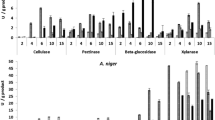Abstract
Present study mainly focused on investigating the feasibility of waste loquat kernels as substrate in submerged culture of Sclerotium rolfsii MT-6 for scleroglucan production. Loquat kernel contained high protein (22.5%) and total carbohydrate (71.2%) contents. Dried and powdered kernels were subjected to acid hydrolysis with 2 N HCl. The obtained hydrolysate was used for the preparation of loquat kernel extract (LKE) and detoxified loquat kernel extract (DLKE). S. rolfsii MT-6 was isolated from fermented squash (Cucurbita pepo). Optimal conditions for scleroglucan production were initial pH 5.0, shaking speed 150 rpm, 28°C, and cultivation time of 72 hr. Production media prepared with DLKE or LKE gave maximum biomass concentrations of 17.06 and 16.21 g/L, and maximum scleroglucan concentrations of 12.08 and 10.53 g/L, respectively. DLKE was also favorable substrate for mycelial growth in a uniform pellet form. This is a first report on the application of waste loquat kernels as scleroglucan production substrate and on the use of a local S. rolfsii isolate for this purpose.
Similar content being viewed by others
References
Farina JI, Sineriz F, Molina OE, Peratti NI. High scleroglucan production by Sclerotium rolfsii: Influence of media composition. Biotechnol. Lett. 20: 825–831 (1998)
Wang Y, McNeil B. Scleroglucan. Crit. Rev. Biotechnol. 16: 185–215 (1996)
McNeil B, Harvey LM. Viscous fermentation products. Crit. Rev. Biotechnol. 13: 275–304 (1993)
Survase SA, Saudagar PS, Bajaj IB, Singhal RS. Scleroglucan: Fermentative production, downstream processing, and applications. Food Technol. Biotech. 45: 107–118 (2007)
Survase SA, Saudagar PS, Singhal RS. Enhanced production of scleroglucan by Sclerotium rolfsii MTCC 2156 by use of metabolic precursors. Bioresource Technol. 98: 410–415 (2006)
Survase SA, Saudagar PS, Singhal RS. Production of scleroglucan from Sclerotium rolfsii MTCC 2156. Bioresource Technol. 97: 989–993 (2006)
Survase SA, Saudagar PS, Singhal RS. Use of complex media for the production of scleroglucan by Sclerotium rolfsii MTCC 2156. Bioresource Technol. 98: 1509–1512 (2007)
Gisbert AD, Romero C, Martinez-Calvo J, Leida C, Llacer G, Badenes ML. Genetic diversity evaluation of a loquat (Eriobotrya japonica (Thunb) Lindl) germplasm collection by SSRs and S-allele fragments. Euphytica 168: 121–134 (2009)
Martinez-Calvo J, Badenes ML, Llacer G, Bleiholder H, Hack H, Meier U. Phenological growth stages of loquat tree (Eriobotrya japonica (Thunb.) Lindl.). Ann. Appl. Biol. 134: 353–357 (1999)
Sutcu H, Demiral H. Production of granular activated carbons from loquat stones by chemical activation. J. Anal. Appl. Pyrol. 84: 47–52 (2009)
Ibarz A, Garvin A, Costa J. Flow behaviour of concentrated loquat juice. Ahmentaria 268: 65–68 (1995)
Freihat NM, Al-Ghzawi AA, Zaitoun S, Alqudah A. Fruit set and quality of loquats (Eriobotrya japonica) as effected by pollinations under sub-humid Mediterranean. Sci. Hortic.-Amsterdam 117: 58–62 (2008)
Koba K, Matsuoka A, Osada K, Huang YS. Effect of loquat (Eriobotrya japonica) extracts on LDL oxidation. Food Chem. 104: 308–316 (2007)
AOAC. Official Methods of Analysis of AOAC Intl. 15th ed. Methods 925.10, 955.04, 920.39, 923.03. Association of Official Analytical Chemists, Arlington, VA, USA (1990)
Hodge JE, Hofreiter BT. Determination of reducing sugars and carbohydrates. Vol. 1, pp. 380–394. In: Methods in Carbohydrate Chemistry. Whistler RL, Wolfrom ML (eds). Academic Press, New York, NY, USA (1962)
Purwadi R, Niklasson C, Taherzadeh MJ. Kinetic study of detoxification of dilute acid hydrolysates by Ca(OH)2. J. Biotechnol. 114: 187–198 (2004)
Barnett HL, Hunter BB. Illustrated Genera of Imperfect Fungi. Macmillan Publishing Company, New York, NY, USA. p. 218 (1987)
Domsch KH, Gams W, Anderson TH. Compendium of Soil Fungi. Vol. 1. Academic Press, London, England. p. 859 (1980)
Dufosse L, De La Broisse D, Guerard F. Fish protein hydrolysates as nitrogen sources for microbial growth and metabolite production. Recent Res. Dev. Microbiol. 1: 365–381 (1997)
Kurbanoglu EB, Kurbanoglu NI. Utilization as peptone for glycerol production of ram horn waste with a new process. Energ. Convers. Manage. 45: 225–234 (2004)
Farina JI, Sineriz F, Molina OE, Perotti NI. Isolation and physicochemical characterization of soluble scleroglucan from Sclerotium rolfsii — Rheological properties, molecular weight, and conformational characteristics. Carbohyd. Polym. 44: 41–50 (2001)
Wang Y, McNeil B. pH effects on exopolysaccharide and oxalic acid production in cultures of Sclerotium glucanicum. Enzyme Microb. Tech. 17: 124–130 (1995)
Rapp P. 1,3-β-Glucanase, 1,6-β-glucanase, and β-glucosidase activities of Sclerotium glucanicum: Synthesis and properties. J. Gen. Microbiol. 135: 2847–2858 (1989)
Van Zyl C, Prior BA, du Preez JC. Production of ethanol from sugarcane bagasse hemicellulose hydrolysate by Pichia stipitis. Appl. Biochem. Biotech. 17: 357–369 (1988)
Palmqvist E, Hahn-Hagerdal B. Fermentation of lignocellulosic hydrolysates. II: Inhibitors and mechanisms of inhibition. Bioresource Technol. 74: 25–33 (2000)
Larsson S, Palmqvist E, Hahn-Hägerdal B, Tengborg C, Stenberg K, Zacchi G. The generation of fermentation inhibitors during dilute acid hydrolysis of softwood. Enzyme Microb. Tech. 24: 151–159 (1999)
Chandel AK, Kapoor RK, Singh A, Kuhad RC. Detoxification of sugarcane bagasse hydrolysate improves ethanol production by Candida shehatae NCIM 3501. Bioresource Technol. 98: 1947–1950 (2008)
Van Sjijdam JC, Kossen NWF, Paul PG. An inoculum technique for the production of fungal pellets. Eur. J. Appl. Microbiol. 10: 211–221 (1980)
Borras E, Blaanquez P, Sarra M, Caminal G, Vicent T. Trametes versicolor pellets production: Low-cost medium and scale-up. Biochem. Eng. J. 42: 61–66 (2008)
Zhang ZY, Jin B, Kelly JM. Production of lactic acid from renewable materials by Rhizopus fungi. Biochem. Eng. J. 35: 251–263 (2007)
Tinoi J, Rakariyatham N, Deming RL. Simplex optimization of carotenoid production by Rhodotorula glutinis using hydrolyzed mung bean waste flour as substrate. Process Biochem. 40: 2551–2557 (2005)
Author information
Authors and Affiliations
Corresponding author
Rights and permissions
About this article
Cite this article
Taskin, M., Erdal, S. & Canli, O. Utilization of waste loquat (Eriobotrya Japonica Lindley) kernels as substrate for scleroglucan production by locally isolated Sclerotium rolfsii . Food Sci Biotechnol 19, 1069–1075 (2010). https://doi.org/10.1007/s10068-010-0150-7
Received:
Revised:
Accepted:
Published:
Issue Date:
DOI: https://doi.org/10.1007/s10068-010-0150-7




